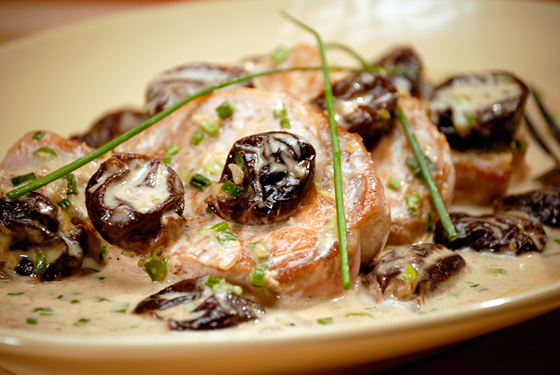Pork Loin Tournedos with Cream and Calvados
Episode 114: Family Favorites
Recipe: Pork Loin Tournedos with Cream and Calvados
In this rich dish, pan juices that result from browning boneless pork steaks, or tournedos, are deglazed with applejack and the sauce is finished with heavy cream. The tournedos are garnished with prunes.
Serves 6
12 ounces large pitted prunes
1 tablespoon peanut oil
6 boneless pork loin chops (about 10 ounces each)
1 teaspoon salt, or to taste
1 teaspoon freshly ground black pepper, or to taste
2 tablespoons chopped shallots or scallions
2 tablespoons Calvados or applejack
1/2 cup homemade chicken stock (see recipe below) or low-salt canned chicken broth, or as needed
3/4 cup heavy cream
1 teaspoon potato starch (see info below), dissolved in 1 tablespoon water
1 tablespoon fresh lemon rind
Put the prunes in a saucepan, cover with cold water, and bring to a boil. Take off the heat, cover, and allow to cool in the cooking liquid.
Preheat the oven to 150 degrees.
Melt the oil in a large heavy skillet. Sprinkle the chops on both sides with the salt and pepper and cook over medium-high heat for 5 minutes on each side. Place on a platter and keep warm in the oven.
Add the shallots or scallions to the pan and cook for 1 minute. Add the Calvados or applejack and stock and bring to a boil. Add the cream, bring to a boil, and cook for 1 minute. Stir in the dissolved potato starch and bring to a boil. If the sauce seems too thick, add a little more chicken stock to thin it; if it is too thin, reduce it for a few more minutes. Taste for seasoning and add salt and pepper if needed. Stir in the lemon juice and strain the sauce through a fine sieve.
Place a pork chop on each of six plates and top each chop with 2 prunes. Arrange the remaining prunes around the meat, coat generously with the sauce, and serve.
CHICKEN STOCK
Makes 3 quarts
It takes very little work to make your own stock; mostly it is a matter of being at home for the several hours it takes to cook. A flavorful money saver that is practically fat- and salt-free, homemade stock can be frozen in small quantities and used as needed.
Chicken backs and necks are available at most supermarkets. If you don’t see them, ask the butcher to set aside some for you. I also make stock from the bones of roasted chicken or turkey.
4 pounds chicken bones (necks, backs, wings, etc.), skinless or with as little skin as possible
6 quarts cold water
1 large onion (about 8 ounces), quartered
1 tablespoon herbes de Provence
12 whole cloves
4 bay leaves
1 tablespoon dark soy sauce (optional)
Combine the bones and water in a large stockpot and bring to a boil over high heat. Reduce the heat and boil gently for 30 minutes. Most of the fat and impurities will rise to the surface; skim off as much of them as you can and discard them.
Add the onion, herbes de Provence, cloves, bay leaves, and soy sauce, if using, return to a boil, and boil gently for 2 1/2 hours. Strain the stock through a fine strainer or a colander lined with dampened paper towels. Allow to cool.
Remove the surface fat and refrigerate the stock for up to 5 days, or pour into containers and freeze.
POTATO STARCH
I often use a “pure starch” — generally potato starch or arrowroot — to finish a sauce and give it a bit of viscosity. If nothing else is available, you can substitute cornstarch, but it tends to make a sauce gooey and gelatinous. I prefer potato starch, which is made from steamed potatoes that are dried and ground. Potato starch is gluten-free and sometimes appears in baked goods, particularly Jewish-Passover specialties. Inexpensive and available in 1-pound packages, it can be found in the Kosher section of many supermarkets and in Asian specialty food shops (it is also used in Japanese cooking). Arrowroot, on the other hand, comes in very small containers and is very expensive.
All of these starches are used in the same way: they are diluted with a little cold liquid — water, wine, or stock — and then stirred into a hot sauce. The starch thickens the sauce on contact and then it is usually brought to a boil.
Copyright © 2011 by Jacques Pépin. Used by permission of Houghton Mifflin Harcourt. All rights reserved.












Ingredient list calls for lemon rind. Instructions call for stirring in lemon juice. Which is it? If grated rind, why strain it out?
rind – on the show he simply peeled off a few strips, and then minced them up. Nice technique!